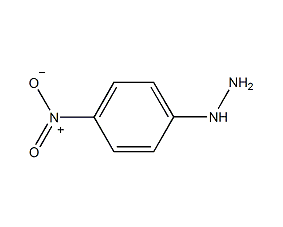p-nitrophenylhydrazine p-nitrophenylhydrazine


Structural formula
| Business number | 02HB |
|---|---|
| Molecular formula | C6H7N3O2 |
| Molecular weight | 153.14 |
| label |
4-Nitrophenylhydrazine, p-Nitrophenylhydrazine, 4-Nitrophenylhydrazine, p-Niphenylhydrazine, 4-Nitrophenylhydrazine (no air transport), O2NC6H4NHNH2, (4-Nitrophenyl)-hydrazin, (P-Nitrophenyl)-hydrazin, Hydrazine, (4-nitrophenyl)-, Hydrazine, (p-nitrophenyl)-, Hydrazine,(4-nitrophenyl)-, p-Hydrazinonitrobenzene, p-Nitrophenylhydrazide, 1-(4-Nitrophenyl)Hydrazine |
Numbering system
CAS number:100-16-3
MDL number:MFCD00007579
EINECS number:202-824-8
RTECS number:MV8225000
BRN number:608107
PubChem number:24883239
Physical property data
1. Properties: orange-yellow crystalline powder [1]
2. Melting point (℃): 156 (decomposition) [2]
3. Octanol/water partition coefficient: 1.41[3]
4. Solubility: slightly soluble in water, soluble in hot water and hot benzene , ethanol, ether, chloroform, ethyl acetate. [4]
Toxicological data
1. Acute toxicity: mouse peritoneal cavity LDLo: 250mg/kg;
2. Mutagenicity: Mutant microorganism test: bacteria – Salmonella typhimurium, 50μg/plate; Mutant microorganism test: Microorganism ,780μg/L.
3. Acute toxicity No data available
4. Irritation No data available
5. Others[5] LDLo: 250mg/kg (mouse abdominal cavity)
Ecological data
1. Ecotoxicity No data available
2. Biodegradability No data available
3 .Non-biodegradability No information available
Molecular structure data
1. Molar refractive index: 41.31
2. Molar volume (cm3/mol): 107.9
3. Isotonic specific volume (90.2K ): 310.8
4. Surface tension (dyne/cm): 68.9
5. Dielectric constant:
6. Dipole moment (10-24cm3):
7. Polarizability: 16.37
Compute chemical data
1. Reference value for hydrophobic parameter calculation (XlogP): None
2. Number of hydrogen bond donors: 2
3. Number of hydrogen bond acceptors: 4
4. Number of rotatable chemical bonds: 1
5. Number of tautomers: none
6. Topological molecule polar surface area 83.9
7.Number of heavy atomsAmount: 11
8. Surface charge: 0
9. Complexity: 137
10. Number of isotope atoms: 0
11. Determine the number of stereocenters of atoms: 0
12. Determine the number of stereocenters of atoms: 0
13. Determine the number of stereocenters of chemical bonds: 0
14. Number of uncertain chemical bond stereocenters: 0
15. Number of covalent bond units: 1
Properties and stability
1. Stability[6] Stable
2. Incompatible substances[7] Strong oxidants, strong reducing agents, strong acids
3. Conditions to avoid contact[8] Friction, vibration or impact
4. Polymerization hazard[9] No polymerization
5. Decomposition products[10] Nitrogen oxides
Storage method
Storage Precautions[11] Store in a cool, ventilated warehouse. Keep away from fire and heat sources. The packaging is sealed. They should be stored separately from oxidants, reducing agents, acids, and food chemicals, and avoid mixed storage. Equipped with the appropriate variety and quantity of fire equipment. Suitable materials should be available in the storage area to contain spills.
Synthesis method
Dissolve p-nitroaniline in hydrochloric acid, cool to 0°C, add sodium nitrite solution for diazotization, and filter. Add the filtrate to the cooled mixed solution of sodium sulfite and sodium hydroxide, add concentrated hydrochloric acid to make it acidic, warm at 25°C for half an hour, and filter to obtain p-nitrophenylhydrazine hydrochloric acid. After being dissolved in water, a deep solution of sodium acetate is added to precipitate p-nitrophenylhydrazine, with a yield of 63-72%.
Purpose
Used as a reagent for testing ketones, aldehydes, sugars, etc. [12]